Swimming with Sharks. Ralph Provisero at Dorsch Gallery.
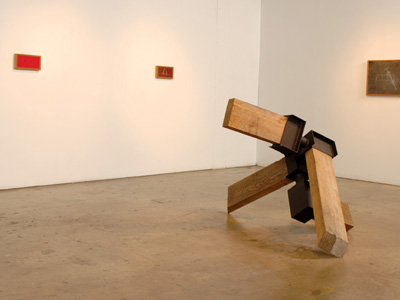 Ralph Provisero is not just a sculptor. He is an artisan, a meticulous craftsman who uses tools and machinery to create his clean and sensual pieces from junkyard steel, transmission gears, cedar boards. That craft was abundantly apparent at the under-sung artist’s latest solo show at the Dorsch Gallery over the summer. “Swimming With Sharks” was a precisely executed, elegant compilation of large and small-scale sculpture, small paintings and drawings; 35 pieces in all. On one level the materials are the most defining elements of Provisero’s show, but so too is the placement. It’s clear that the hands behind these curves and lines leave no hair out of place.
Ralph Provisero is not just a sculptor. He is an artisan, a meticulous craftsman who uses tools and machinery to create his clean and sensual pieces from junkyard steel, transmission gears, cedar boards. That craft was abundantly apparent at the under-sung artist’s latest solo show at the Dorsch Gallery over the summer. “Swimming With Sharks” was a precisely executed, elegant compilation of large and small-scale sculpture, small paintings and drawings; 35 pieces in all. On one level the materials are the most defining elements of Provisero’s show, but so too is the placement. It’s clear that the hands behind these curves and lines leave no hair out of place.
But back to the materials.
“I find out if anyone knows of a building being demolished or something,” explains Provisero about how he scrounges up his raw materials, during a walk-through of “Sharks” in the sprawling warehouse space. Or people might donate bits of industrial detritus. And then they become fodder for a work of art, generally in the same shape they were found. The original dimensions of the beam or the plank often dictate the make-up of the final piece, says Provisero.
Here in the front room, the three large wood, steel, and stone sculptures literally took center stage, exactly placed and expertly lit in the middle of the floor. The heavy pieces look like they are leaning on each other ever-so delicately, balancing only on the pointed tips of the cedar lumber – they look like you could push them over with the punch of a finger. Except there’s no way you could. These are trademark works of Provisero, familiar in form and style to previous pieces, such as the sculptures for the Bass Museum or on Navy Pier in Chicago.
Hanging on the surrounding walls were smaller, quirkier works, with names such as “Dusted,” “Stung,” and “Bull.” These are collaged from steel, stone, aluminum – and 1960s automobile car relics. “They were cleaning out a warehouse, and here was this box of old car emblems. Beautiful,” says Provisero pointing to the sign whose metal calligraphy reads “Stingray,” the name of a classic Chevy Corvette. Mirroring in a sense the work of the artist himself, these emblems were clearly design-intensive, and made of serious metal.
Other paintings appear matte and light from a distance but up close are shiny and hard, as they are pigmented shellac on copper-coated resin board, the result looking like car paint. They are studies for the sculptures in front of them. This material dries in seconds once it’s brushed on, so, says Provisero, when you make your mark, you permanently make your mark.
It shouldn’t come as a surprise that Provisero is as influenced by architecture and engineering as by classical art, or that he started his career at 17 as an art handler. “I’m very particular about placement,” says the graduate of the Kansas City Art Institute, whose studio is his backyard, where he taught himself to weld. “I visualize everything in advance, I know how everything will fit.” That applies to not only the sculpture itself, but to its placement with others.
For this Dorsch show, he knew exactly how he wanted it to look, having worked with this huge, two-room gallery many times before. “In this case (of “Sharks”), I would say it’s more an installation than a show. The space is part of it.”
This streak was strong enough to earn him an invite earlier this year, along with several architects, to a design residency at the Atlantic Center for the Arts in New Smyrna Beach. The group was holed up together and tasked with a design and build project. The resulting structure incorporated several of Provisero’s ideas, including its circular form and placement “to catch the wind.” Which it does.
{mospagebreak}
Water, not wind, could be the theme that kept “Sharks” flowing, as the title suggests but at first glance is not readily seen. Again, pieces made from such heavy industrial materials don’t shout out “fluidity,” but again Provisero’s work is not easily type-cast. So why this title? There are clues scattered about both rooms. Like “Landshark” (okay, not hard to find this clue): it’s a simple and beautiful small piece that sits on the floor, made of cedar with a black steel base, and it looks like a fin. Yes, says Provisero, the inspiration “was very ‘Jaws’.”
There’s the self-explanatory “Landshark 3D Wire Study” on one wall, and a deceptively simple small black ball on red resin board, called “Eyeball” – the only thing you might see of the fearsome fish when underwater. “I saw the wood that looked like a fin, and I thought, this is the shark capital of the world, and it went from there,” explains Provisero.
The fin is in the second room, where the artist wanted to be more playful with the works, he says. The sculptures on the floor are wrought from the rim of a rig, a propane tank, white marble and in the case of the most stunning piece hanging on the back wall, from metal lamp shades and rope. The whole thing is painted black, one end of the rope tied in a knot, on the other end a hook from a crane is attached.
“The hook is a 7 1/2 ton crane hook that I had to ‘whip’ on to the rope to create a closed loop,” he explains. (“Whipping,” he says, is when you sew the end of a rope shut.) “The other end of the rope was then whipped and sealed into part of a crane extension connection creating the other side.”
The way the final sculpture is draped on the wall can make it appear like a ship’s rope … or a black pearl necklace. “The contrast comes from the pearls, which are a very light gauge metal and are extremely fragile.”
It’s hard to imagine how parts of a mega construction machine morphed with lamp shades could look so sublime. The horizontal of the necklace was a planned positioning – he didn’t want stacked spheres that wound up “a meaningless vertical modern sculpture.” This way there is movement to it, with asymmetrical ends “lighter on one end, so it’s much more seamless and beautiful.”
Provisero uses descriptions for other pieces that likewise defy the weight of the work, such as “translucent,” “rippling,” and “flowing.” In a great touch, every sculpture in “Sharks” has a piece of black, usually painted steel. The work is about “pure form, no distractions,” says Provisero. “It’s not labored. It brings it to the most simple level.”

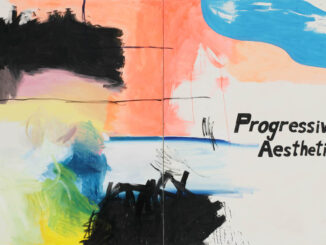
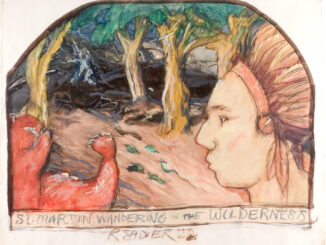
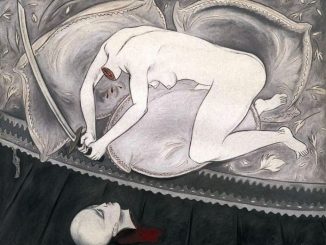
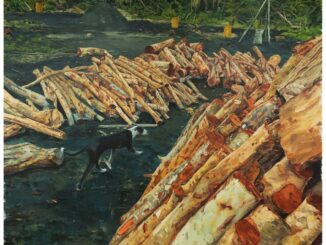
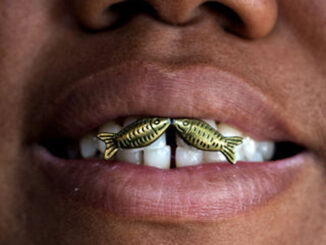
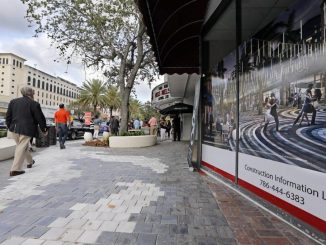
Be the first to comment